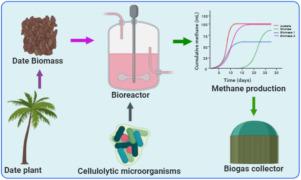Environmental Technology & Innovation ( IF 6.7 ) Pub Date : 2020-09-24 , DOI: 10.1016/j.eti.2020.101180 K. Chandrasekhar , Roent Dune A. Cayetano , Ikram Mehrez , Gopalakrishnan Kumar , Sang-Hyoun Kim

|
Date biomass is a renewable natural resource since it can be substituted in a comparatively shorter period. Hence it is considered as a possible feedstock for bioenergy motivations through anaerobic digestion (AD). Despite the fact AD is a fully demonstrated technology, the use of new feedstock necessitates detailed investigation. Worldwide several researchers are evaluating methane yield short of paying much consideration to the source type and structural and elemental composition of biomass. Hence, the current study was intended to relate methane yield to those two structural and chemical composition of biomass. In this sense, biochemical methane potential (BMP) for different date biomass, namely Pedicels, Fibrilium, Petiole, Fruit bunch, Spath, Palm, and a mixture of all biomass samples was tested for 30 days. Among all the experimental variations, higher productivity was observed with Palm as 72.60 mL CH4/g VS/days, followed by Spath (66.61 mL CH4/g VS/days), Mixed biomass (64.57 mL CH4/g VS/days), Fruit bunch (64.34 mL CH4/g VS/days), Pedicels (59.06 mL CH4/g VS/days), Fibrilium (57.42 mL CH4/g VS/days), and Petiole (41.17 mL CH4/g VS/days). From the experimental results, it can be concluded that among all the biomass samples, Palm is the best substrate for higher methane production. However, the remaining experimental conditions produced methane yield was comparatively low. This might be due to the composite nature of the substrate with lignin as an insoluble fraction. Hence, Pedicels, Fibrilium, and Petiole biomasses cannot be recommended as a substrate for biogas production without appropriate pretreatment.
中文翻译:

评价不同种类的阿尔及利亚枣生物量的生化甲烷潜力
枣生物质是可再生的自然资源,因为它可以在较短的时间内被替代。因此,它被认为是通过厌氧消化(AD)产生生物能动力的可能原料。尽管AD是一项经过充分证明的技术,但使用新原料仍需要进行详细研究。在全球范围内,几位研究人员正在评估甲烷的产量,但并未过多考虑生物质的来源类型,结构和元素组成。因此,当前的研究旨在将甲烷产量与生物质的这两种结构和化学组成联系起来。从这个意义上说,测试了30天不同日期生物质的生化甲烷潜力(BMP),这些生物分别为Pedicels,纤维,叶柄,水果束,Spath,Palm和所有生物质样品的混合物。4 / g VS /天,其次是Spath(66.61 mL CH 4 / g VS /天),混合生物质(64.57 mL CH 4 / g VS /天),水果束(64.34 mL CH 4 / g VS /天),花梗(59.06 mL CH 4 / g VS /天),纤丝虫草(57.42 mL CH 4 / g VS /天)和叶柄(41.17 mL CH 4/ g VS /天)。从实验结果可以得出结论,在所有生物质样品中,Palm是产生更高甲烷的最佳基质。但是,剩余的实验条件产生的甲烷产率相对较低。这可能是由于底物与木质素作为不溶级分的复合性质。因此,如果不进行适当的预处理,则不建议将Pedicels,纤维状和叶柄生物质作为沼气生产的底物。











































 京公网安备 11010802027423号
京公网安备 11010802027423号